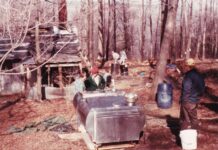“At the time of our hike, the Appalachian Trail was 59 years old. That is, by American standards, incredibly venerable. The Oregon and Santa Fe trails didn’t last as long. Route 66 didn’t last as long.
The old coast-to-coast Lincoln Highway, a road that brought transforming wealth and life to hundreds of little towns, so important and familiar that it became known as “America’s Main Street,” didn’t last as long. Nothing in America does.
If a product or enterprise doesn’t constantly re-invent itself, it is superseded, cast aside, abandoned without sentiment in favor of something bigger, newer, and alas, nearly always uglier.
And then there is the good old AT, still quietly ticking along after six decades, unassuming, splendid, faithful to its founding principles, sweetly unaware that the world has quite moved on. It’s a miracle really.”
– by Bill Bryson
A Walk In The Woods: Rediscovering America on the Appalachian Trail
I’ve never hiked more than just small sections of state forest, so it is nearly impossible for me to grasp the huge undertaking of hiking the 2,200-some miles of the Appalachian Trail from Georgia to Maine.
Author Bill Bryson chose to set aside six weeks for the first leg of the trail, starting in the south in early March.
Though the exact number of miles involved in the trail is a matter of some uncertainty, Bryson points out, “What is certain is that it is a long way, and from either end it is not easy.
“The peaks of the Appalachian Trail are not particularly formidable as mountains go – but they are big enough and they go on and on.
“Altogether is takes about five months, and 5 million steps, to walk the trail from end to end.”
Bryson laments that the ecological balance of the trail isn’t nearly as protected as one would assume it to be, and he is rankled by the National Park Service in this regard.
No protection. He tells of one account after another in which endangered animal and plant life is not protected, and some in which action is taken that is bound to disturb or destroy such life.
In 1957, he tells of the brilliant plan to “reclaim” Abrams Creek in the Little Tennessee River for rainbow trout, though rainbow trout had never been native to Abrams Creek.
Biologists dumped several drums of a poison called rotenone into 15 miles of creek.
“Within hours, tens of thousands of dead fish were floating on the surface like autumn leaves. Among the 31 species of Abrams Creek fish that were wiped out was one called the smoky madtom, which scientists had never seen before.
“Thus, Park Service biologists managed the wonderfully unusual accomplishment of discovering and eradicating in the same instant a new species of fish.”
Considering that was 40 years ago, “such foolishness would be unthinkable in these more enlightened times,” Bryson notes with a measure of worried sarcasm.
No research. He laments the fact that the National Park Service spends almost nothing – less than 3 percent of its budget – on research of any type, and trees are dying “in colossal numbers” while 90 plant species have disappeared from the grassy balds (treeless, meadowy expanses of mountaintop) since the park was opened in the 1930s.
“At least 25 more (plant species) are expected to go in the next few years. There is no plan to save them.”
Bryson points out that the Smokies “achieved their natural splendor without the guidance of a national park service and don’t actually need it now.”
Much of the upkeep along the trail is accomplished by dedicated volunteers.
But he acknowledges that some of the most devastating losses in Appalachia came before the Park Service stepped in to the picture.
He describes photographs of old, majestic American chestnuts, trees that stood a hundred feet from the forest floor, soaring boughs spread out unbelievably – so huge that the people look incredibly tiny next to them.
Back before the Asian fungus hit the United States in 1904 and swept the Appalachians, one tree in every four was a chestnut. The mortality rate as a result of the American chestnut blight was 100 percent.
Imagine how different our American landscape would be if not for that.
Getting the chance to view these majestic trees would have been reason enough to want to hike the Appalachian Trail.
Or maybe not. Through wind, rain, snow, mud, biting flies and ticks, bear, mice, rats, other hikers of questionable background, tasteless meals day after day and no running water at the end of a day of hiking with 40 to 50 pounds strapped on … I think not.
Get 4 Weeks of Farm and Dairy Home Delivered












